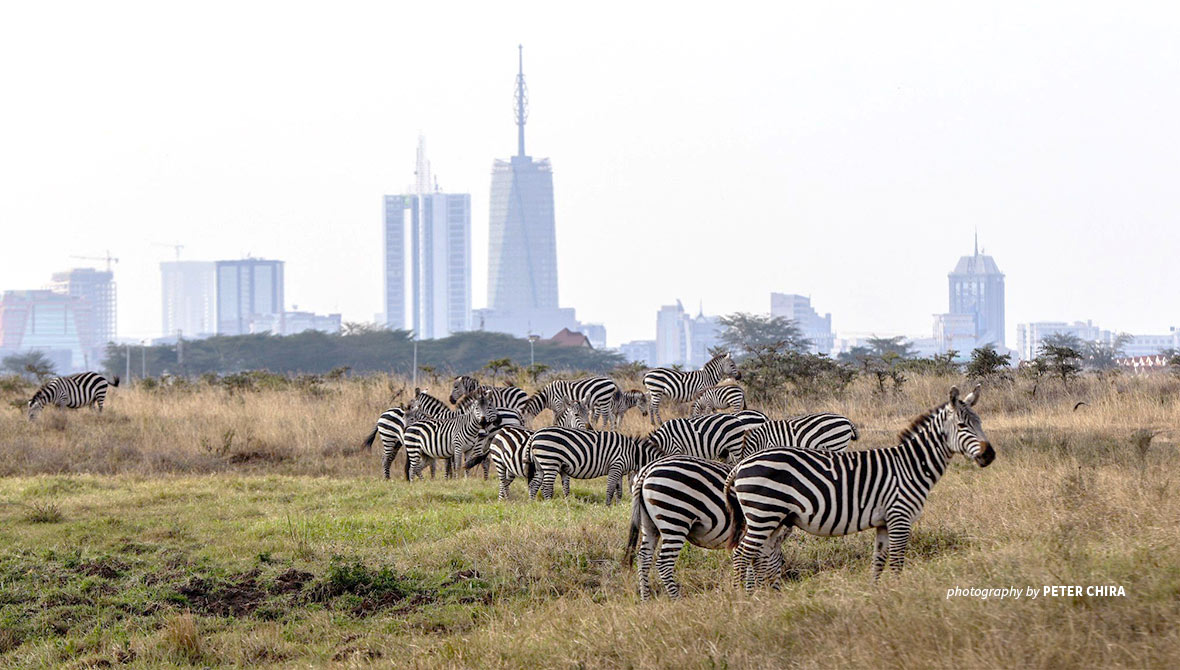Overcoming low literacy levels to foster community-based conservation in Kenya

The Nairobi National Park is a uniquely situated protected area in the capital city of Kenya
This article is developed and written by the second cohort of the Charles R. Wall Young African Policy Fellows Program and the inaugural Conservation Leadership and Management Fellowship. Both programs aim to build the leadership, negotiation, and communication skills of young African professionals in the conservation sector.
Nairobi National Park is one of Kenya’s most significant wildlife conservation areas, home to over 100 species of mammals, including lions, leopards, and rhinos, and over 400 bird species. Established and gazetted in 1946, it is the oldest protected area in the country. Covering an area of 117.21 sq. kilometers, the park is located within the capital city of Nairobi, making it a uniquely situated conserved area.
However, despite its incredible biodiversity value, the park’s long-term sustainability faces compounding threats of habitat loss, poaching, and human-wildlife conflict. A 2021 academic study highlighted that low literacy levels among communities around the Nairobi National Park are a significant barrier to promoting wildlife conservation and curbing unsustainable land use practices.
Illiteracy among local communities has exacerbated impacts on conservation by limiting the ability of communities to access information on the consequences of environmental degradation, thus inhibiting their ability to make informed decisions for a sustainable local ecosystem. At the same time, low literacy levels can also limit one’s ability to access economic opportunities, entrenching cycles of poverty and environmental degradation. According to a study in 2016, 54 percent of households surveyed in the Athi-Kapiti ecosystem, which includes the Nairobi National Park, had at least one adult with no formal education. The study also found that people with low literacy levels had limited knowledge of conservation laws and the consequences of illegal activities such as poaching and charcoal burning.
The impact of low literacy levels in communities can often be worsened by language barriers, which can inhibit the ability of people to understand the technical nature of conservation issues as enforced by park management authorities. This dynamic can have a marginalizing effect, where on the one hand, it can lead to negative attitudes towards conservation initiatives and reluctance to support park management efforts. On the other, it may prevent the participation and decision-making of communities in conservation. Ultimately, their ability to contribute to processes that affect their livelihoods and the park’s resources dwindles, which can result in a lack of ownership and support for conservation initiatives by those living near a protected area.
Developing innovative communication tools for conservation
Effective conservation is almost impossible without the support of local communities. Conservation organizations and authorities at Nairobi National Park must adopt tailored approaches to overcome barriers like illiteracy. Innovative strategies could include working with local communities to develop stories that communicate conservation needs and actions to people of various literacy levels. For instance, easy-to-read conservation story books with simplified terms in local languages and clear illustrations utilize culturally relevant contexts to tell conservation stories and facilitate learning.
Additionally, distributing low-cost mobile phones loaded with audio-visual materials such as podcasts and videos in local languages could help people learn about conservation. Similarly, establishing community radio stations that focus on educating listeners about conservation can be developed and produced in local languages can focus on the real-time conservation issues experienced around the national park.
Organizing interactive and educational field trips for local communities to the Nairobi National Park can help people learn about and experience conservation in a hands-on way.
At the same time, creating knowledge exchange platforms for local communities in the form of conservation debate clubs or theater groups will allow the verbal transfer of knowledge between communities and the protected area authorities. This can improve the broader understanding of local communities’ perceptions towards conservation, help identify the knowledge gaps, and ease problem-solving procedures.
Overall, these solutions must be co-developed with community members in recognition of their valuable knowledge, skills, and resources. In this way, communities become inclined to participate in conservation through opportunities for empowerment, ownership, and accountability. Furthermore, it also provides unique opportunities to mainstream traditional knowledge and beliefs into conservation practice.